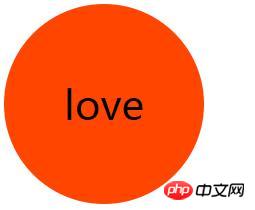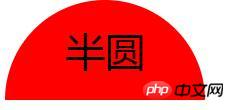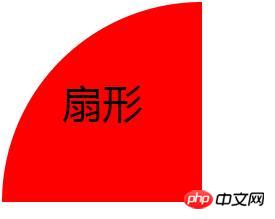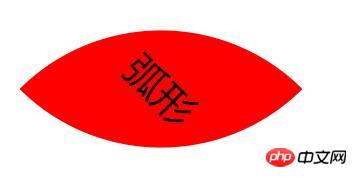Create common graphics using the border-radius property in CSS3
CSS3 has added many new attributes, some of which are very practical. They not only improve work efficiency, but also make the page look better. For example, the border-radius property in CSS3, we can use it to draw some commonly used graphics, thus reducing the burden on artists. This article will share with you how to use the border-radius attribute to create a perfect circle, semicircle, sector, and arc. Friends who are interested can take a look, I hope it can help you.
1. Use border-radius to make a perfect circle
The four values of the border-radius attribute represent: upper left corner, upper right corner, lower right corner, lower left corner, If only one value is set, it means that the four corners are the same size. When we draw a circle, we only need to set the four corner values to half the length of the div. The length and width of the div are both 200px, and the four corner values are 50% (here, 100px). The code is as follows:
div{
width: 200px;
height: 200px;
background: orangered;
border-radius: 50%;
line-height: 200px;
text-align: center;
font-size: 40px;
}Rendering:

2. Use border-radius to make a semicircle
Semicircle The upper left corner and upper right corner are rounded corners, and the lower right corner and lower left corner are right angles. Set the values in the upper left corner and upper right corner to half the length of the div, and leave the values in the lower right corner and lower left corner unchanged to 0; in addition, set the height value to half the original height to be a standard semicircle. The code is as follows:
div{
width: 200px;
height: 100px;
background: red;
border-radius: 100px 100px 0 0;
line-height: 100px;
text-align: center;
font-size: 40px;
}Rendering:

3. Use border-radius to make a fan-shaped
fan-shaped one The upper left corner is rounded, and the other three corners are right angles. Just set the value of the upper left corner to the same value as the width and height, and leave the values of the other three corners unchanged (equal to 0). The code is as follows:
div{
width: 200px;
height: 200px;
background: red;
border-radius: 200px 0 0;
line-height: 200px;
text-align: center;
font-size: 40px;
}Rendering:

4. Use border-radius to make an arc
Arc Its two opposite angles change, but the other two opposite angles remain unchanged. Set its upper left corner and lower right corner to the same value as the width and height, and leave the upper right corner and lower left corner unchanged (equal to 0). Also add a transform attribute to rotate it into a flat arc. The code is as follows:
div{
width: 200px;
height: 200px;
background: red;
line-height: 200px;
text-align: center;
font-size: 40px;
border-radius: 200px 0;
-webkit-transform: rotate(45deg);
-ms-transform: rotate(45deg);
-o-transform: rotate(45deg);
transform: rotate(45deg);
}Rendering:

The above introduces some practical skills of the border-radius attribute in CSS3, which we can use when laying out the page. It draws some simple graphics. Friends who are interested can try it themselves to see if they can create other good-looking effects.
The above is the detailed content of Create common graphics using the border-radius property in CSS3. For more information, please follow other related articles on the PHP Chinese website!

Hot AI Tools

Undresser.AI Undress
AI-powered app for creating realistic nude photos

AI Clothes Remover
Online AI tool for removing clothes from photos.

Undress AI Tool
Undress images for free

Clothoff.io
AI clothes remover

AI Hentai Generator
Generate AI Hentai for free.

Hot Article

Hot Tools

Notepad++7.3.1
Easy-to-use and free code editor

SublimeText3 Chinese version
Chinese version, very easy to use

Zend Studio 13.0.1
Powerful PHP integrated development environment

Dreamweaver CS6
Visual web development tools

SublimeText3 Mac version
God-level code editing software (SublimeText3)

Hot Topics
 1378
1378
 52
52
 How to write split lines on bootstrap
Apr 07, 2025 pm 03:12 PM
How to write split lines on bootstrap
Apr 07, 2025 pm 03:12 PM
There are two ways to create a Bootstrap split line: using the tag, which creates a horizontal split line. Use the CSS border property to create custom style split lines.
 How to insert pictures on bootstrap
Apr 07, 2025 pm 03:30 PM
How to insert pictures on bootstrap
Apr 07, 2025 pm 03:30 PM
There are several ways to insert images in Bootstrap: insert images directly, using the HTML img tag. With the Bootstrap image component, you can provide responsive images and more styles. Set the image size, use the img-fluid class to make the image adaptable. Set the border, using the img-bordered class. Set the rounded corners and use the img-rounded class. Set the shadow, use the shadow class. Resize and position the image, using CSS style. Using the background image, use the background-image CSS property.
 How to resize bootstrap
Apr 07, 2025 pm 03:18 PM
How to resize bootstrap
Apr 07, 2025 pm 03:18 PM
To adjust the size of elements in Bootstrap, you can use the dimension class, which includes: adjusting width: .col-, .w-, .mw-adjust height: .h-, .min-h-, .max-h-
 The Roles of HTML, CSS, and JavaScript: Core Responsibilities
Apr 08, 2025 pm 07:05 PM
The Roles of HTML, CSS, and JavaScript: Core Responsibilities
Apr 08, 2025 pm 07:05 PM
HTML defines the web structure, CSS is responsible for style and layout, and JavaScript gives dynamic interaction. The three perform their duties in web development and jointly build a colorful website.
 How to set up the framework for bootstrap
Apr 07, 2025 pm 03:27 PM
How to set up the framework for bootstrap
Apr 07, 2025 pm 03:27 PM
To set up the Bootstrap framework, you need to follow these steps: 1. Reference the Bootstrap file via CDN; 2. Download and host the file on your own server; 3. Include the Bootstrap file in HTML; 4. Compile Sass/Less as needed; 5. Import a custom file (optional). Once setup is complete, you can use Bootstrap's grid systems, components, and styles to create responsive websites and applications.
 How to use bootstrap button
Apr 07, 2025 pm 03:09 PM
How to use bootstrap button
Apr 07, 2025 pm 03:09 PM
How to use the Bootstrap button? Introduce Bootstrap CSS to create button elements and add Bootstrap button class to add button text
 How to view the date of bootstrap
Apr 07, 2025 pm 03:03 PM
How to view the date of bootstrap
Apr 07, 2025 pm 03:03 PM
Answer: You can use the date picker component of Bootstrap to view dates in the page. Steps: Introduce the Bootstrap framework. Create a date selector input box in HTML. Bootstrap will automatically add styles to the selector. Use JavaScript to get the selected date.
 How to use bootstrap in vue
Apr 07, 2025 pm 11:33 PM
How to use bootstrap in vue
Apr 07, 2025 pm 11:33 PM
Using Bootstrap in Vue.js is divided into five steps: Install Bootstrap. Import Bootstrap in main.js. Use the Bootstrap component directly in the template. Optional: Custom style. Optional: Use plug-ins.




